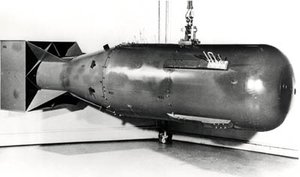Little Boy
|
|
"Little Boy" was the codename given to the nuclear weapon dropped on Hiroshima, Japan on Monday, August 6, 1945. It was dropped from a B-29 Superfortress, the Enola Gay piloted by Lt. Col. Paul Tibbets, from about 31,000 feet (9450 m). The device exploded at approximately 8:15 a.m. (JST) when it reached an altitude of 1,800 ft (550 m).
It was the first of the only two nuclear weapons that have ever been used in warfare.
The Mk I "Little Boy" was 10 feet (3 m) in length, 28 inches (71 cm) wide and weighed 8,900 lb (4000 kg). The design used a gun arrangement to explosively force a sub-critical mass of uranium-235 and three U-235 target rings together into a super-critical mass, initiating a nuclear chain reaction. It contained 60 kg U-235, of which 0.7 kg underwent fission. The uranium was enriched at the massive plants in Oak Ridge, Tennessee during the Manhattan Project.
The yield of "Little Boy" was about 13 kilotons of TNT equivalent in explosive force, i.e. 5.5×1013 joule = 55 TJ (terajoule).
Approximately 70,000 people were killed as a direct result of the blast, and a similar number were injured. A great number more would later die as a result of nuclear fallout and cancer.[1] (http://www.yale.edu/lawweb/avalon/abomb/mp10.htm) Pregnant mothers lost their children, or they were born with deformities. Clothing was burned into the skin.
At the time there had never been a test explosion with this type of weapon. The only test explosion of a nuclear weapon was with the plutonium-type, on July 16, 1945 at the Trinity site. This was because tests of controlled nuclear reactions with U-235 (as opposed to the uncontrolled reaction that occurs in a bomb) had already been done, and the principles involved were so simple that it was taken to be unnecessary to test the weapon in advance. Furthermore, there was relatively little of the necessary uranium-235. The military was also anxious to drop the bomb, and testing the device would have delayed its use until more uranium was ready.
Gun-type_Nuclear_weapon.png
Although used occasionally in later experimental devices, the design was used only once as a weapon because of the extreme danger of a misfire. A simple crash could drive the "bullet" into the "target" and release lethal radiation doses or even a full nuclear detonation. The danger of misfire was even greater over water. Even if the force of a crash did not set the bomb off, if water entered the fail safe system, it would be shorted out, possibly leading to a detonation of the bomb. The British Red Beard nuclear weapon also suffered from this flaw.
It has been conjectured that a small fraction of the source uranium used for the Little Boy or (after conversion to plutonium) the Fat Man bombs may have been produced in Germany. Uranium was reportedly secured by Manhattan Project scientific director Robert Oppenheimer from the surrendering German submarine U-234. The German U-boat had been en route to deliver the uranium and other top secret German warfare technology to the then Empire of Japan. However U-234 surrendered following the end of hostilities in the European war theatre and Germany's unconditional surrender. Two Japanese military officials on board the German vessel committed suicide and were buried at sea. There are conflicting assessments of the importance of the German material to the Manhattan Project. The German uranium was likely to have been un-enriched uranium oxide which would have yielded a small fraction of the amount of fissionable material used in the Little Boy. Conversely if the uranium was fully enriched, it seems unlikely that Germany would be exporting enough material to make a number of nuclear weapons to Japan. Recent literature has claimed that uranium oxide recovered from Germany had been used for the Soviet nuclear program.
See also
External links
- Description (http://gawain.membrane.com/hew/Nwfaq/Nfaq8.html#nfaq8.1.3) at Nuclear Weapons Archivede:Little Boy
es:Little Boy ja:リトルボーイ nl:Little Boy pl:Little Boy zh:小男孩原子彈

